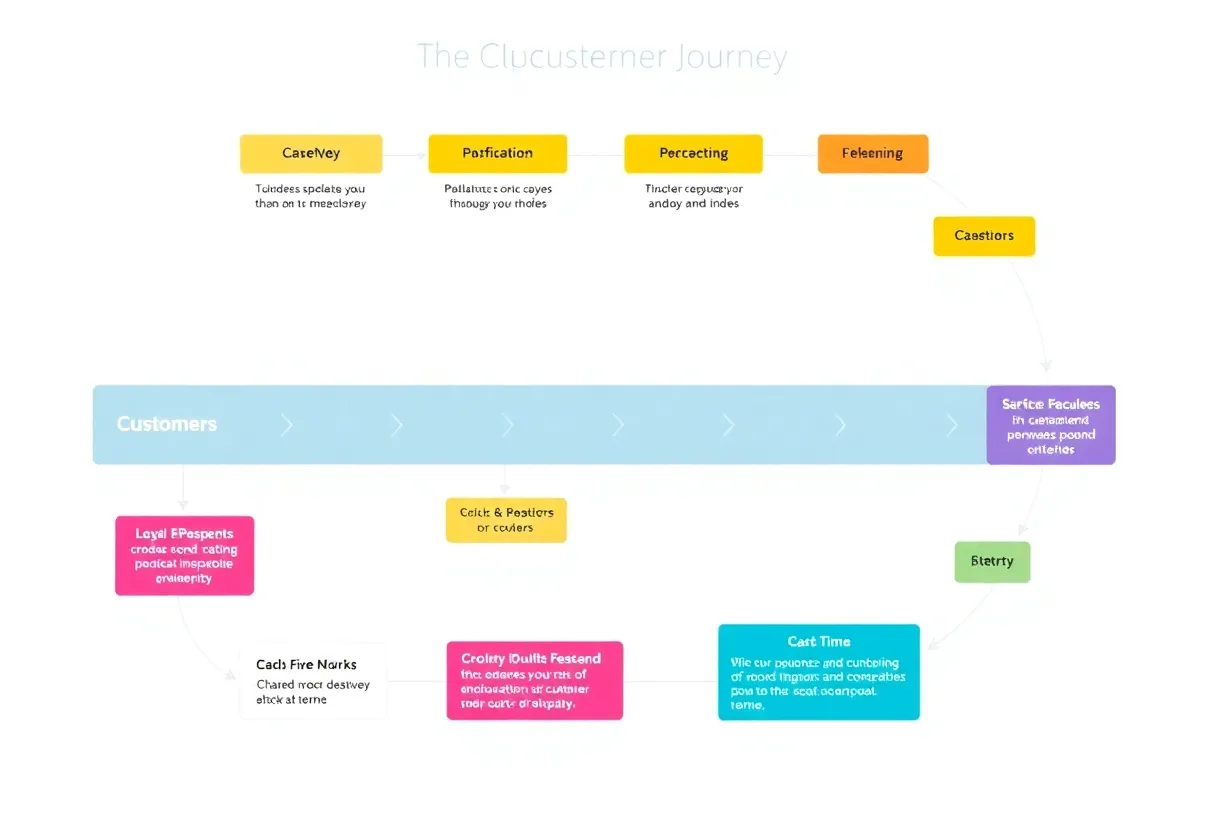

Colorful flowchart illustrating customer journey stages and pathways.
Article Sponsored by:
Real Internet Sales is a digital marketing agency located in Columbia, South Carolina. We specialize in website design and development, SEO, social media management, online advertising, AI integration, and workflow automation. Our services also include affiliate marketing and digital strategy.
Real Internet Sales also offer specialized programming for real estate firms, using IDX and RETS feeds to automatically populate MLS properties on their websites for improved property listings and sales. We also work with clients in the restaurant, tourism, and e-commerce industries to enhance their digital presence and streamline operations.
Customer journey mapping is an essential strategy for modern marketing. It helps businesses visualize the experience of customers as they interact with a brand. Understanding this journey supports tailored marketing efforts, enhancing customer satisfaction and driving conversion rates. This article explores effective ways to implement customer journey mapping for marketing success.
Customer journey mapping captures the various stages a customer encounters when engaging with a brand. This includes awareness, consideration, decision-making, retention, and advocacy. By grasping this journey, businesses can identify pain points, moments of delight, and opportunities for improvement.
Implementing customer journey mapping can significantly enhance your marketing success. It enables:
1. Improved Customer Experience: By understanding each touchpoint, companies can tailor experiences to meet and exceed customer expectations.
2. Data-Driven Decisions: Provides valuable insights for marketers to optimize strategies and campaigns, based on actual customer behavior.
3. Alignment Across Departments: Creates a unified view of the customer experience, encouraging collaboration across teams, including marketing, sales, and customer service.
Start by determining what you hope to achieve with customer journey mapping. This may include:
1. Enhancing Customer Experience: Identify specific stages that may require more attention.
2. Increasing Conversion Rates: Focus on improving the purchasing experience.
3. Understanding Customer Needs: Build a clearer picture of what customers want at different touchpoints.
Assemble a detailed profile of your target audience. Key considerations include:
1. Demographics: Age, gender, location, and income.
2. Behavior Patterns: How do they interact with your brand? What are their preferences?
3. Goals and Pain Points: What motivates them, and what obstacles do they face?
Develop a visual representation of the customer journey. Identify the following stages:
1. Awareness: How do potential customers discover your brand?
2. Consideration: What factors influence their decisions?
3. Purchase: What is their buying process like?
4. Retention: How can you keep customers engaged post-purchase?
5. Advocacy: How can satisfied customers turn into brand advocates?
Detail every interaction customers have with your brand across multiple channels. This includes:
1. Website: How does the website design affect user experience?
2. Social Media: How do social media campaigns influence engagement?
3. Email Marketing: What role does email play in customer retention?
4. Customer Service: How effective is customer support in resolving issues?
Understanding the emotions customers experience at each stage is crucial. Assess:
1. Pain Points: Identify areas of frustration throughout the journey.
2. Joy Points: Highlight moments when customers feel satisfied or delighted.
3. Expectations: How well do your offerings meet customer needs at each touchpoint?
Utilize various data sources to enrich your customer journey map. Data collection methods may include:
1. Surveys: Gather direct feedback from customers regarding their experiences.
2. Analytics: Use web and social media analytics to track customer behavior.
3. Interviews: Conduct in-depth discussions to gain qualitative insights.
Design your customer journey map to encapsulate all the insights collected. Include:
1. Visual Elements: Use graphs, diagrams, and flowcharts for clarity.
2. Narrative: Tell the story of the customer experience through engaging text.
3. Insights: Summarize the key findings from each stage and touchpoint.
Share your customer journey map with stakeholders and customers. This step is essential for:
1. Gaining Feedback: Ensure that the map aligns with actual customer experiences.
2. Making Adjustments: Based on feedback, refine the map for accuracy.
Utilize insights from the journey map to develop marketing and customer engagement strategies. Focus on:
1. Targeted Marketing Campaigns: Develop campaigns that resonate with each stage of the customer journey.
2. Improved Customer Service: Equip customer service teams with better resources to address concerns at various touchpoints.
3. Enhanced Content Creation: Create relevant content that aligns with customer needs throughout their journey.
Customer journey mapping is not a one-time task. It requires ongoing review and refinement. Key actions include:
1. Tracking Changes: Monitor shifts in customer behavior over time.
2. Regular Updates: Adjust the journey map as new data emerges and customer preferences evolve.
3. Continuous Improvement: Seek ways to continually enhance the customer experience.
Bring in members from marketing, sales, customer service, and product development. Diverse perspectives provide a holistic understanding of the customer journey.
Leverage customer relationship management (CRM) systems, analytics tools, and journey mapping software. These resources expedite data collection and visualization.
Ensure that the mapping process maintains a strong focus on the customer. Every stage should reflect customer needs, desires, and emotions.
Avoid overcomplicating the map. The clearer and more concise the representation, the easier it will be for stakeholders to understand and act upon.
Effectively implementing customer journey mapping is a vital step toward marketing success. By understanding and visualizing each touchpoint in the customer experience, businesses can identify areas for improvement, ultimately leading to heightened customer satisfaction and loyalty. Prioritize a customer-centric approach and continuously refine your strategies to remain agile in today’s competitive marketplace.

7001 St Andrews Rd #329 ,
Columbia, SC 29212,
United States
Phone: (+1) 803 708 5514
News Summary A stabbing incident at a Walmart in Traverse City, Michigan, on July 26,…
News Summary The Michigan Supreme Court has ruled that Jacqueline Davis can continue her lawsuit…
News Summary GOP Representative Bill Huizenga has announced he will not run for the U.S.…
News Summary The U.S. Department of Justice is intensifying scrutiny over voter registration accuracy in…
News Summary The Palisades Nuclear Power Plant in Michigan is preparing to become the first…
News Summary MJR Theatres has officially launched Michigan's largest laser IMAX screen in Troy, enhancing…